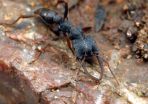(Press-News.org) This news release is available in German.
Objects with sizes in the nanometer range, such as the molecular building blocks of living cells or nanotechnological devices, are continuously exposed to random collisions with surrounding molecules. In such fluctuating environments the fundamental laws of thermodynamics that govern our macroscopic world need to be rewritten. An international team of researchers from Barcelona, Zurich and Vienna found that a nanoparticle trapped with laser light temporarily violates the famous second law of thermodynamics, something that is impossible on human time and length scale. They report about their results in the latest issue of the prestigious scientific journal Nature Nanotechnology.
Surprises at the nanoscale
Watching a movie played in reverse often makes us laugh because unexpected and mysterious things seem to happen: glass shards lying on the floor slowly start to move towards each other, magically assemble and suddenly an intact glass jumps on the table where it gently gets to a halt. Or snow starts to from a water puddle in the sun, steadily growing until an entire snowman appears as if molded by an invisible hand. When we see such scenes, we immediately realize that according to our everyday experience something is out of the ordinary. Indeed, there are many processes in nature that can never be reversed. The physical law that captures this behavior is the celebrated second law of thermodynamics, which posits that the entropy of a system – a measure for the disorder of a system – never decreases spontaneously, thus favoring disorder (high entropy) over order (low entropy).
However, when we zoom into the microscopic world of atoms and molecules, this law softens up and looses its absolute strictness. Indeed, at the nanoscale the second law can be fleetingly violated. On rare occasions, one may observe events that never happen on the macroscopic scale such as, for example heat transfer from cold to hot which is unheard of in our daily lives. Although on average the second law of thermodynamics remains valid even in nanoscale systems, scientists are intrigued by these rare events and are investigating the meaning of irreversibility at the nanoscale.
Nanoparticles in laser traps
Recently, a team of physicists of the University of Vienna, the Institute of Photonic Sciences in Barcelona and the Swiss Federal Institute of Technology in Zürich succeeded in accurately predicting the likelihood of events transiently violating the second law of thermodynamics. They immediately put the mathematical fluctuation theorem they derived to the test using a tiny glass sphere with a diameter of less than 100 nm levitated in a trap of laser light. Their experimental set-up allowed the research team to capture the nano-sphere and hold it in place, and, furthermore, to measure its position in all three spatial directions with exquisite precision. In the trap, the nano-sphere rattles around due to collisions with surrounding gas molecules. By a clever manipulation of the laser trap the scientists cooled the nano-sphere below the temperature of the surrounding gas and, thereby, put it into a non-equilibrium state. They then turned off the cooling and watched the particle relaxing to the higher temperature through energy transfer from the gas molecules. The researchers observed that the tiny glass sphere sometimes, although rarely, does not behave as one would expect according to the second law: the nano-sphere effectively releases heat to the hotter surroundings rather than absorbing the heat. The theory derived by the researchers to analyze the experiment confirms the emerging picture on the limitations of the second law on the nanoscale.
Nanomachines out of equilibrium
The experimental and theoretical framework presented by the international research team in the renowned scientific journal Nature Nanotechnology has a wide range of applications. Objects with sizes in the nanometer range, such as the molecular building blocks of living cells or nanotechnological devices, are continuously exposed to a random buffeting due to the thermal motion of the molecules around them. As miniaturization proceeds to smaller and smaller scales nanomachines will experience increasingly random conditions. Further studies will be carried out to illuminate the fundamental physics of nanoscale systems out of equilibrium. The planned research will be fundamental to help us understand how nanomachines perform under these fluctuating conditions.
INFORMATION:
Original publication in Nature Nanotechnology:
Dynamic Relaxation of a Levitated Nanoparticle from a Non-Equilibrium Steady State. Jan Gieseler, Romain Quidant, Christoph Dellago, and Lukas Novotny. Nature Nanotechnology AOP, February 28, 2014. DOI: 10.1038/NNANO.2014.40
Never say never in the nano-world
2014-03-31
ELSE PRESS RELEASES FROM THIS DATE:
New human trial shows stem cells are effective for failing hearts
2014-03-31
WASHINGTON (March 31, 2014) — Patients with severe ischemic heart disease and heart failure can benefit from a new treatment in which stem cells found in bone marrow are injected directly into the heart muscle, according to research presented at the American College of Cardiology's 63rd Annual Scientific Session.
"Our results show that this stem cell treatment is safe and it improves heart function when compared to placebo," said Anders Bruun Mathiasen, M.D., research fellow in the Cardiac Catherization Lab at Rigshospitalet University Hospital Copenhagen, and lead investigator ...
Real-world heart procedure results consistent with scientific research
2014-03-31
WASHINGTON (March 31, 2014) — The first one-year outcomes data of transcatheter heart valve replacement (TAVR) in nearly all U.S. patients undergoing this procedure shows that real-world outcomes are comparable to or slightly better than those found in clinical trials, according to registry data presented at the American College of Cardiology's 63rd Annual Scientific Session. However, specific baseline characteristics of patients undergoing TAVR are associated with differing degrees of death and survival and may be important considerations for patient counseling and shared ...
Newly discovered molecule may offer hope for immune disorders and runaway inflammation
2014-03-31
A new research discovery published in the April 2014 issue of the Journal of Leukocyte Biology may open the door to new therapies that help treat immune disorders or curb runaway inflammation. Specifically, scientists have discovered a molecule that can induce cell death (apoptosis) in a key type of immune cell (dendritic cells). With this understanding, it may be possible to develop new therapies that essentially shut down dendritic cell activity, and thereby reducing an immune reaction.
"We hope that our findings provide better understanding of immune regulation, which ...
NASA releases images of X-class solar flare
2014-03-31
The sun emitted a significant solar flare, peaking at 1:48 p.m. EDT March 29, 2014, and NASA's Solar Dynamics Observatory captured images of the event. Solar flares are powerful bursts of radiation. Harmful radiation from a flare cannot pass through Earth's atmosphere to physically affect humans on the ground, however -- when intense enough -- they can disturb the atmosphere in the layer where GPS and communications signals travel.
To see how this event impacted Earth, please visit NOAA's Space Weather Prediction Center at http://spaceweather.gov, the U.S. government's ...
Stats show growth of breast lifts outpacing implants 2 to 1
2014-03-31
VIDEO:
New statistics from the American Society of Plastic Surgeons show that since 2000, breast lift procedures have grown by 70 percent, twice the rate of breast implants. According to the...
Click here for more information.
ARLINGTON HEIGHTS, Ill., March 31, 2014 – New statistics released today by the American Society of Plastic Surgeons (ASPS) show that breast lift procedures are growing at twice the rate of breast implant surgeries. Since 2000, breast lifts have grown by ...
Comparison of drug-releasing stents show similar safety outcomes after 2 years
2014-03-31
A comparison of the safety of biodegradable polymer biolimus-eluting stents vs durable polymer everolimus-eluting stents finds similar outcomes for measures including death and heart attack after two years, according to a JAMA study released online to coincide with presentation at the 2014 American College of Cardiology Scientific Sessions.
Recent studies have raised concerns about the safety of biodegradable polymer drug-eluting stents (BP-DES) compared with durable polymer everolimus-eluting stents (DP-EES). The NOBORI Biolimus-Eluting vs XIENCE/PROMUS Everolimus-Eluting ...
Six new Dracula ants from Madagascar: Minor workers become queens in Mystrium
2014-03-31
Six new species of Dracula ants from the Malagasy region have been discovered by scientists at the California Academy of Sciences. The discoveries, by postdoctoral fellow Masashi Yoshimura from Japan and curator of entomology Brian L. Fisher, represent a completely new twist in the typically rigid caste system of ants, where anatomy is typically destiny. The study was published in the open access journal ZooKeys.
"The genus Mystrium is the most mysterious group within the bizarre Dracula ants," said Yoshimura.
Mystrium species have unique features such as long, spatulate ...
Study further illuminates heart-healthy benefits of Mediterranean diet
2014-03-31
(WASHINGTON, March 31, 2014) – New research further illuminates the heart-healthy benefits of the Mediterranean diet, tying the eating plan to lower levels of platelets and white blood cells, two markers of inflammation. Inflammation has an association with greater risk of heart attack and stroke. Study, results are published online today in Blood, the Journal of the American Society of Hematology (ASH).
The Mediterranean diet, characterized by generous servings of foods such as greens, whole grains, fish, and olive oil, has long been hailed as a heart-healthy eating ...
Scientists discover a number of novel genetic defects which cause oesophageal cancer
2014-03-31
A team of scientists from the Cancer Science Institute of Singapore (CSI Singapore) at the National University of Singapore and National University Cancer Institute Singapore (NCIS), and their collaborators from the Cedars-Sinai Medical Centre, UCLA School of Medicine, demonstrated that a number of novel genetic defects are able to induce oesophageal cancer.
The research group, led by Professor H. Phillip Koeffler, Senior Principal Investigator at CSI Singapore and Deputy Director of NCIS, has conducted a successful comprehensive genomic study of oesophageal squamous ...
What will climate policy mean for coal?
2014-03-31
Limiting climate change to 2°C means shutting down coal power plants - an unpopular proposition for coal power companies. But a new study shows that delaying climate policies could prove even worse for power plant owners.
Coal power plants are a major source of greenhouse gas emissions, and new plants are planned around the world, particularly in India and China. These new power plants are built to run for 30-50 years, paying off only after years of operation. But stringent climate policies could make the cost of emission so high that coal power generation is no longer ...




